It’s summertime, and chances are that most ladies’ plans include a venture to a beach at some point. As a long time lover of the sand and the waves, wild horses can’t drag me away from the shore once the weather warms up. However, even despite my love of the water, as my shore trips draw near, I always experience some apprehension about swimwear. I often find myself thinking upon a yesteryear, enamoured with the idea of being able to enjoy the ocean in a comfortable amount of clothing without looking odd to those around me. At the same time, It is rather freeing to be able to enjoy the environment a little less inhibited. Feeling torn about how to enjoy the beach modestly and comfortably is something that women throughout the ages have wrestled with.
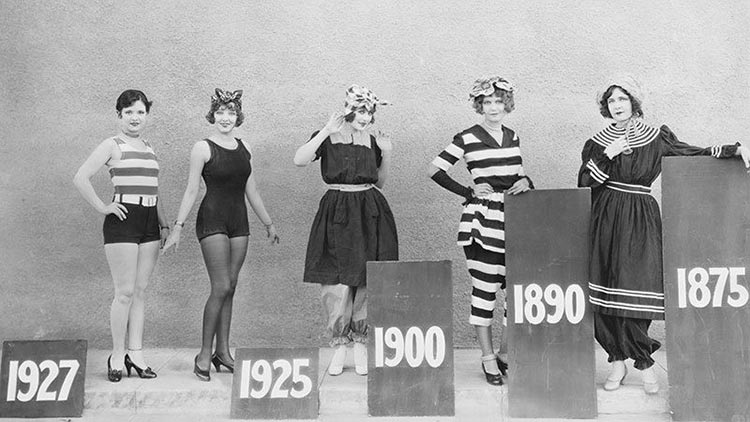
Beach pyjamas also came out in the 1930s
Bathhouses
In the beginning, women had no real option but to enjoy beach bathing au natural. Clothing was often heavy and too weighty for swimming or material it was made of was not well suited to water. If we look back to ancient times, bathing was just that, bathing, for the purposes of getting clean. Therefore it was often done at bathhouses in rooms separated according to gender. Or it could be done privately at an outdoor water source. Many women chose to do this nude or sometimes in a small bathing suit top similar to today’s bandeau top and simple loose-fitting bottoms. Ceramic tile representations of this swimwear have survived to give us a vague idea of what societal standards for ladies of this age may have been. This lasted until the middle ages when public bathing seems to cease and desist altogether.
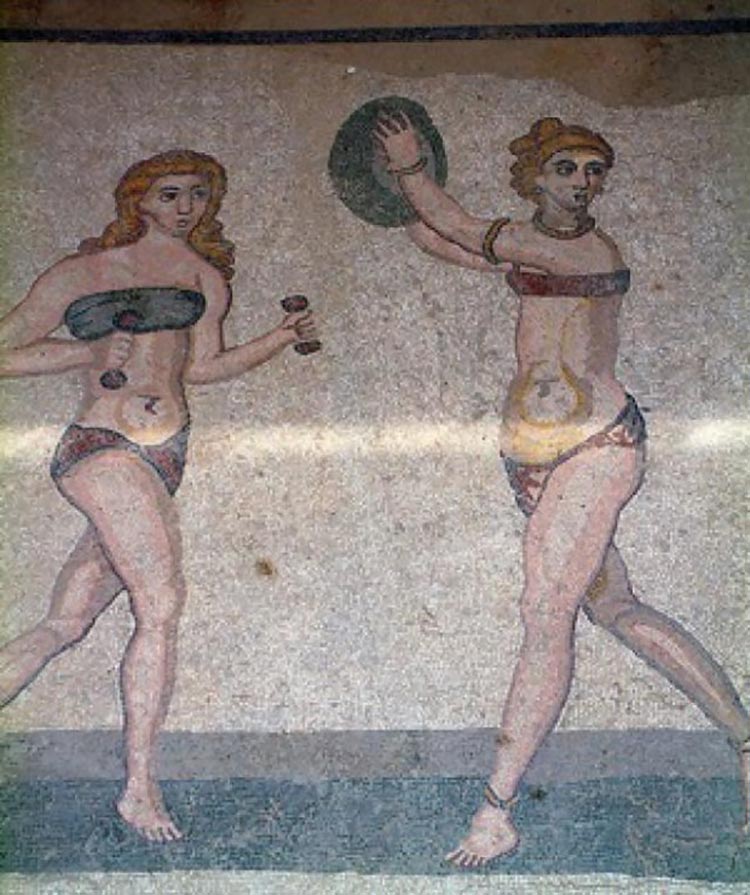
Roman Ancient Bikini Girls
The mosaic christened as ‘ancient bikini girls’, was found by an archaeological excavation of the ancient Roman villa near Piazza Armerina in Sicily. It may have been made in the 4th century CE by North African artists since some of the tesserae (the pieces of the mosaic) come from Africa.
Victorian Era
We don’t see public beach bathing reemerge in popularity again until the Victorian Era, although some spas did pop up in France and England in the 17th and 18th centuries that promoted bathing, sometimes in mixed company, for health promotion. To say that women approached public swimming with extreme caution is an understatement. In a time when propriety was paramount, it was tremendously important not to let that be compromised, even for ease and comfort of swimming. Bathing Machines, or wagons to allow female swimmers to bathe within four walls and safe from public viewing were even used to hide ladies from the public eye. Truthfully, it probably wouldn’t have been safe to immerse yourself in the swimwear of the 17 and 1800s, which featured the usual corsets and abundance of petty coats.
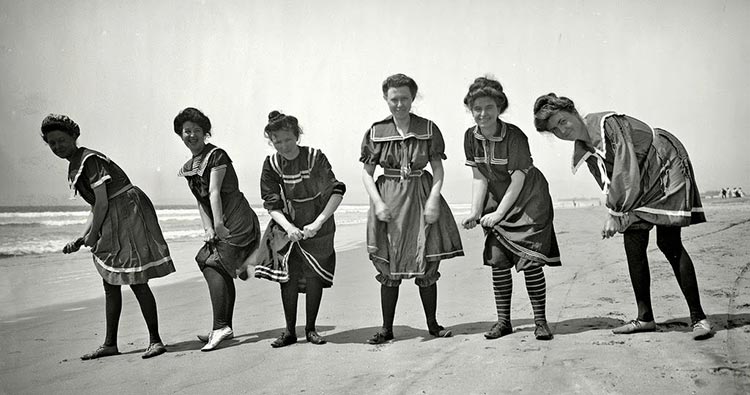
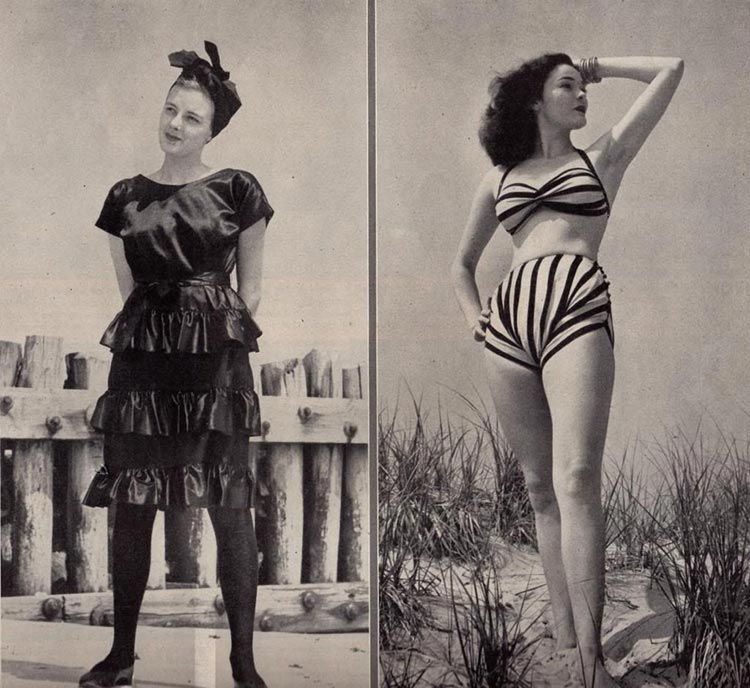
Anyone who has ever worn vintage clothing is familiar with the weight that accompanies the many layers of fabric. Some women even sewed weights into their hemlines to keep their skirts from floating and exposing their legs. Just imagine that fabric now weighed down with gallons of water. It’s easy to see how drowning was a real danger.
The main difference between beach clothing and street clothing seems to be solely in the length of the skirt which was about knee length.
However, women still wore bloomers, stockings and shoes beneath these shortened petty coats, so it does make one wonder, what advantage these beach looks provided at all. By 1855 some beachwear featured a shorter-sleeved day dress with an apron, bloomers and black stockings providing a bit more freedom.
Mermaids at Brighton by William Walker
Things finally began to change between 1900 and 1920 for a number of reasons. The larger overarching theme in western culture was of course World War I and how it dramatically changed social roles that had been long set for hundreds of years.
In this particular case, women found themselves having more freedoms in general due to a move toward women’s suffrage and their contributions in the work and war front during a critical period.
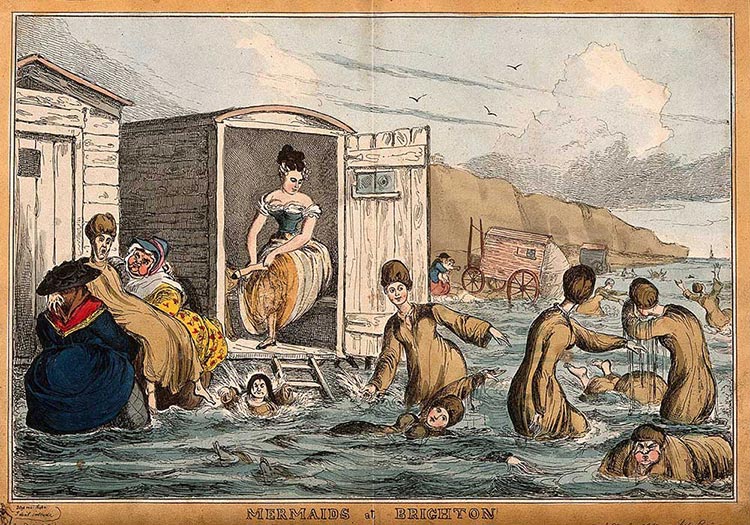
In the case of swimming, it was no longer a criminal offence by 1910 for women to bare their legs and arms in public. Also, swimming was growing in popularity as a sport and also as a class in school. As a result, the swimsuits became more functional, though they still were made of wool. They most often were sleeveless tailored jumpers that fell about mid-thigh. Since it was fitted, it finally did serve to allow women to swim and move unencumbered in the water. In 1915, the term “swimsuit” was coined by the Jantzen company in Portland, Oregon to introduce their “red diving girl” logo and their line of wool swimwear.
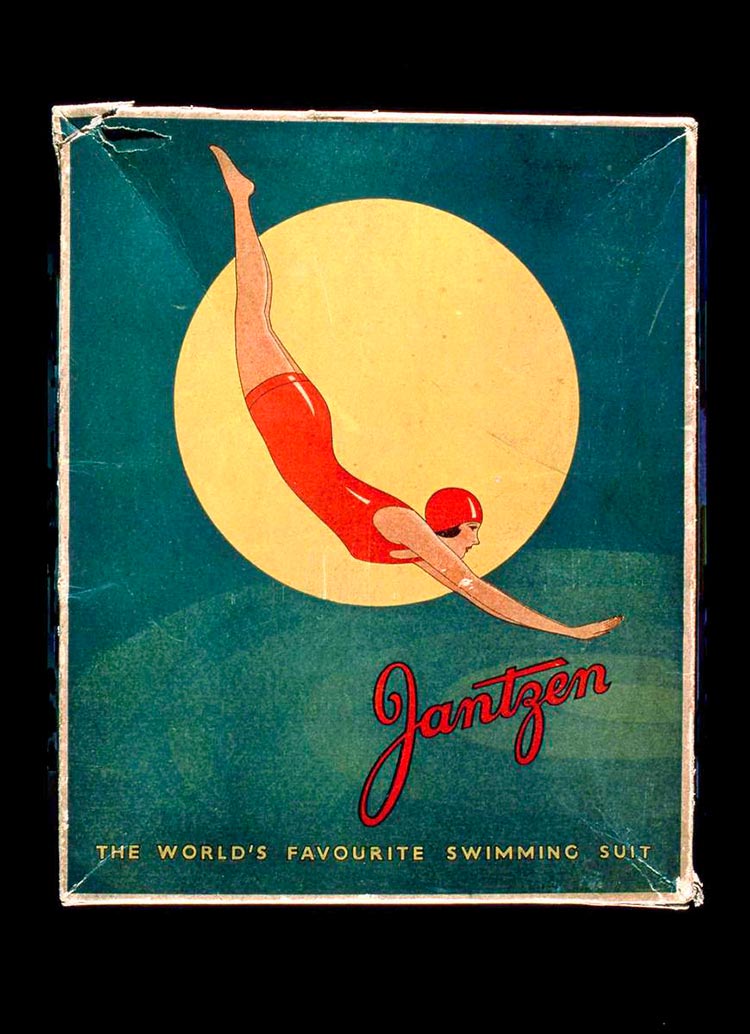

1940,s Two-Piece Bathing Suit
In the 1930s we begin to see a swimsuit that finally resembles today’s modern one-piece swimsuit.
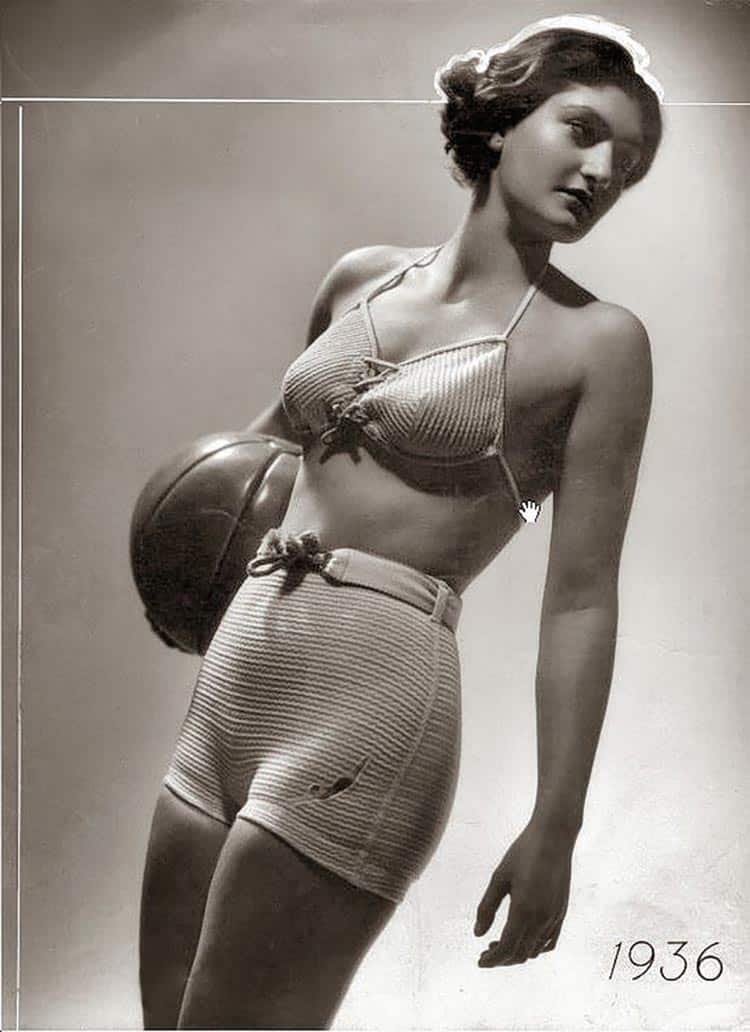
Swimsuits became curve-hugging, and fully bared arms and legs. They also were made of fabrics more ideal for the sport of swimming like latex. The bottom half of the suit was more like an extremely mini skirt than the brief bottoms that we see in today’s swimwear. The early 1940s saw swimwear taken to a whole new level in the debut of the two-piece bathing suit. These bathing suits, however, were always high waisted and most definitely always covered the belly button, since it was still viewed as indecent to bare the lower abdomen.
1946 saw the unveiling of the true bikini, invented by Louis Reard, which did bear the navel. Is was deemed so scandalous that models would not even wear it on the runway in Paris. The first woman to model it was actually an exotic dancer, Micheline Bernardini! That same summer, women began to experiment with wearing it on the beaches of Cannes. Over the next decades, the bikini made it’s the societal transition from shameful display to standard pool and beachwear throughout western culture.

1950’s
In the 1950s the popular body ascetic was curves, curves and more curves. However, swimsuit fabrics lacked a supportive structure to enhance ladies curves. Many corset companies contributed and bathing wear of the era to create a bathing suit that had light boning all throughout the midsection, flattening tummies and boosting bosoms to meet the beauty standards of the day.
By the time the 1960s came, women were really looking for freedom from the structure in a big way. Mentally and socially everyone, especially young women, was finally ready to embrace the bikini. The increase of private pools in residences allowed ladies to adjust to a new level of coverage in a comfortable setting. Bikinis in this era still provided full coverage of the chest and lower half, while revealing the belly button. In 1965 textile companies developed a new fabric called Lycra/Spandex. Of course, today we are all familiar with this product and probably have quite a few things at our fingertips in our wardrobes that contain these synthetic materials.
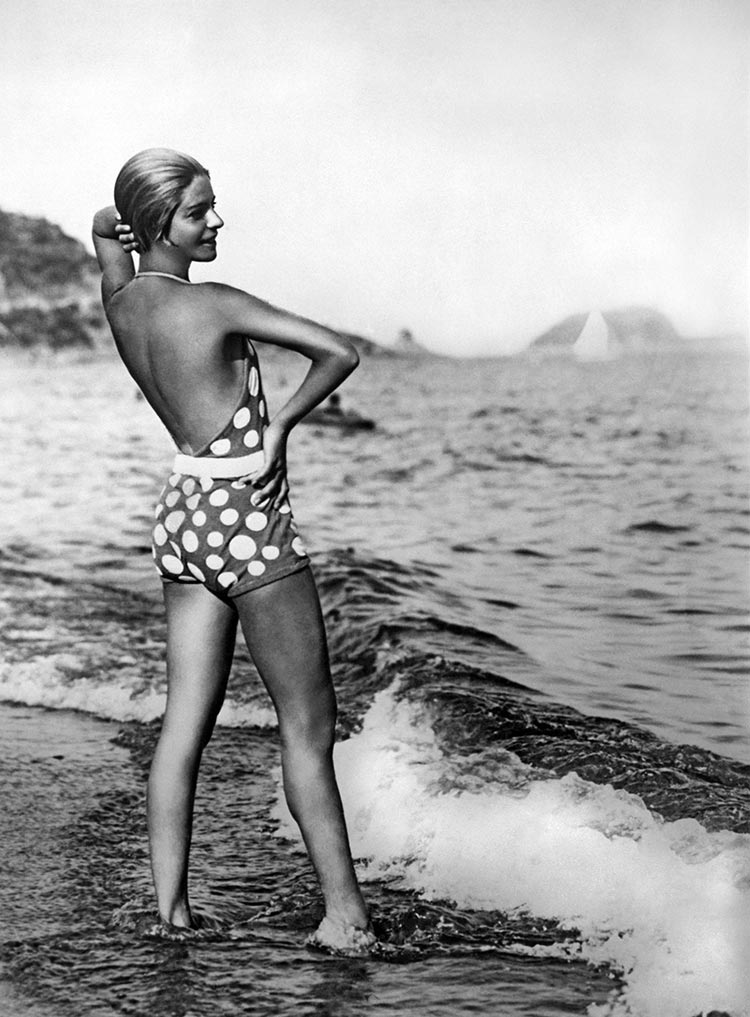
Spandex allowed swimsuits to be tight-fitting like a glove and quick-drying, making them perfect for true water sportsmanship.
1960 Swimsuit Advertisement
From the 1970s and through the 1990’s we saw leg lines in the bathing suit rise, midriffs grow and straps thin. Eventually, this gave way to trends like the string bikini, strapless suit, and even thong beachwear, leaving modern women to question what actually remained in the outfit. It’s true that some modern trends beg the question, “why not just go nude?”
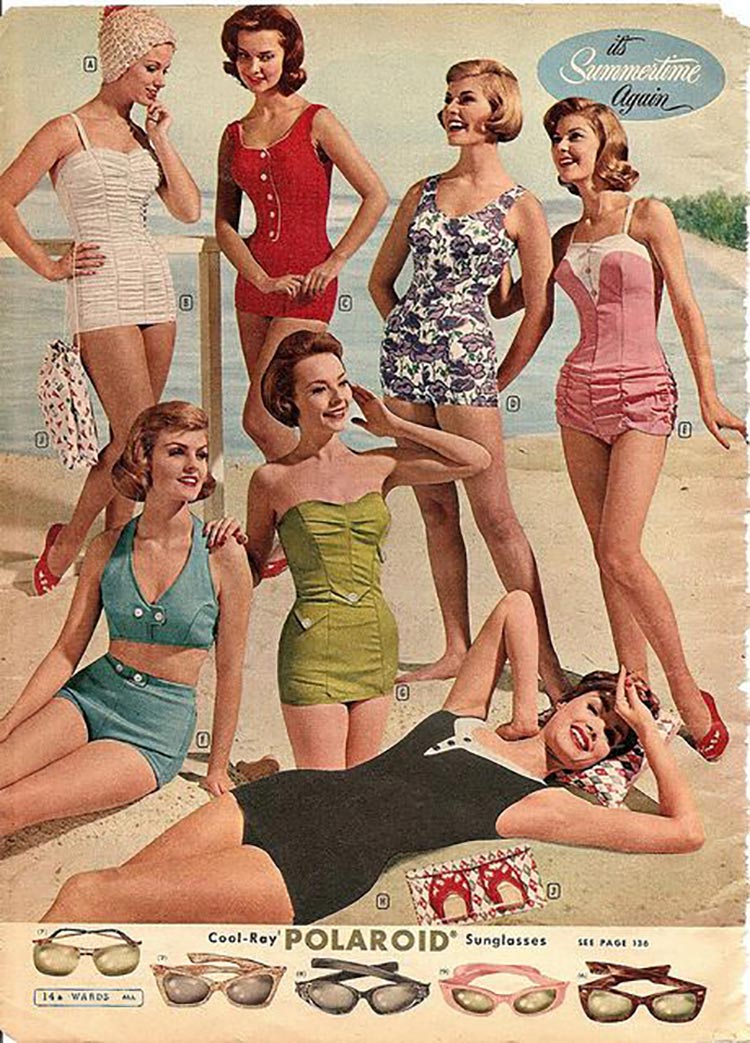
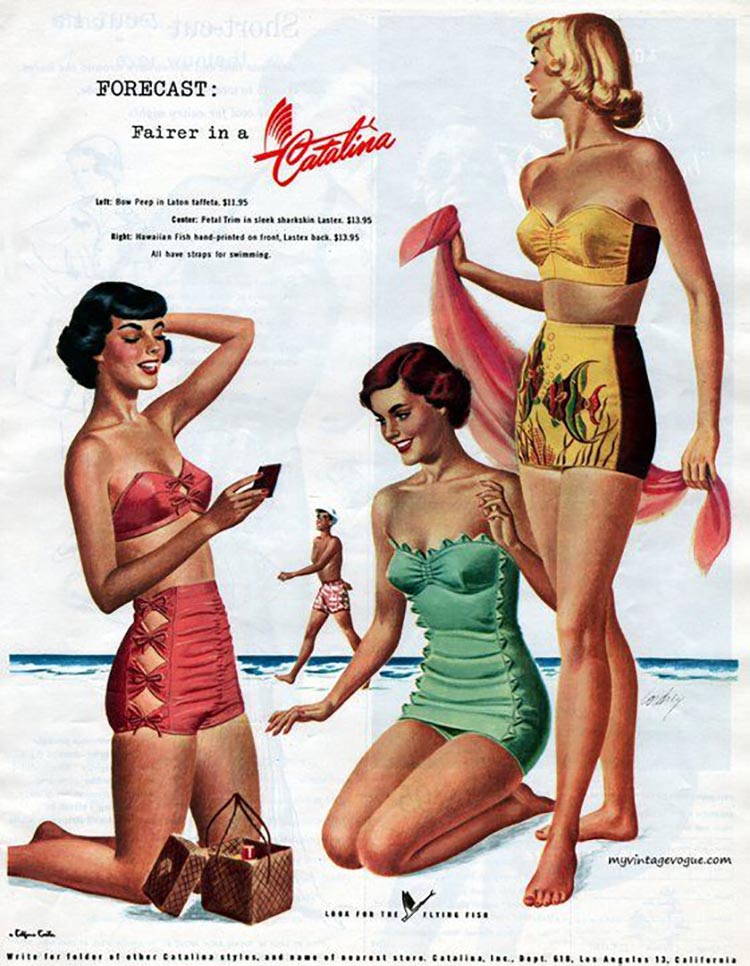
Ladies of Baywatch Circa 1990 Swimwear
I believe that this is the true question for the women of today as we look to our past to define our present and future. When it comes to swimwear, we’ve been from practically naked to completely clothe and then back again.

All the while, in culture swimsuits, have almost always represented sexuality, creating even further complexities for ladies who swim publicly. Women are left asking themselves if today’s swimwear is celebratory, innocuous, functional or exploitative? While some women may relish the chance to celebrate their bodies by baring it all, others may feel more comfortable in modest attire. I think it’s safe to say that every woman wants to find that perfect garment that leaves them feeling attractive, comfortable and ready for a day of activity. The beauty of living in this day in age is that women are finally free to choose for themselves what is beautiful and practical without fear of societal repercussions that plagued our fore-bearers. Self-determination and choices are what make up the spice of life, especially when it comes to beach attire. Here are a few options for beachgoers that give a nod to yesteryear while still being chic enough for today.

















You must be logged in to post a comment.